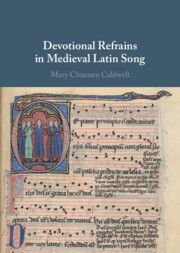Book contents
- Devotional Refrains in Medieval Latin Song
- Devotional Refrains in Medieval Latin Song
- Copyright page
- Dedication
- Contents
- Figures
- Tables
- Music Examples
- Acknowledgments
- Abbreviations
- Introduction: Latin Song and Refrain
- 1 Latin Song and Refrain in the Medieval Year
- 2 Refrains and the Time of Song
- 3 Singing the Refrain
- 4 Remembering Refrains
- 5 Retexting Refrains
- 6 Conclusion
- Appendix Latin Refrain Songs
- Bibliography
- Index of Works
- General Index
1 - Latin Song and Refrain in the Medieval Year
Published online by Cambridge University Press: 24 March 2022
- Devotional Refrains in Medieval Latin Song
- Devotional Refrains in Medieval Latin Song
- Copyright page
- Dedication
- Contents
- Figures
- Tables
- Music Examples
- Acknowledgments
- Abbreviations
- Introduction: Latin Song and Refrain
- 1 Latin Song and Refrain in the Medieval Year
- 2 Refrains and the Time of Song
- 3 Singing the Refrain
- 4 Remembering Refrains
- 5 Retexting Refrains
- 6 Conclusion
- Appendix Latin Refrain Songs
- Bibliography
- Index of Works
- General Index
Summary
Chapter 1 contextualizes the performance of the refrain song within the feasts and seasons of the church and calendar year, situating the repertoire within in a pluralistic temporal framework. The Latin refrain and refrain song are identified as inherently seasonal and calendrical forms of musical expression, emerging out of broader clerical and monastic interest in musically amplifying specific periods of the year. In addition to examining the calendrical ordering of refrain songs across manuscript sources, this chapter considers how festive calendrical time was disciplined and reframed through song and refrain. This analysis is informed by the textual witnesses of Eudes Rigaud’s thirteenth-century Regestrum, and song collection prefaces attributed to Johannes de Perchausen and Bishop Richard Ledrede in the Moosburger Graduale and Red Book of Ossory, respectively. The chapter closes with a case study of refrains and refrains songs for the New Year (January 1), a highly contested day in the medieval year that fused popular and devotional rituals and, consequently, invited condemnation as well as musical and poetic accretions. Musico-poetic celebration of the New Year involved one refrain in particular, “annus novus,” leading to a dense network of associations between theological texts, devotional songs, and festive rituals.
Keywords
- Type
- Chapter
- Information
- Devotional Refrains in Medieval Latin Song , pp. 24 - 64Publisher: Cambridge University PressPrint publication year: 2022



